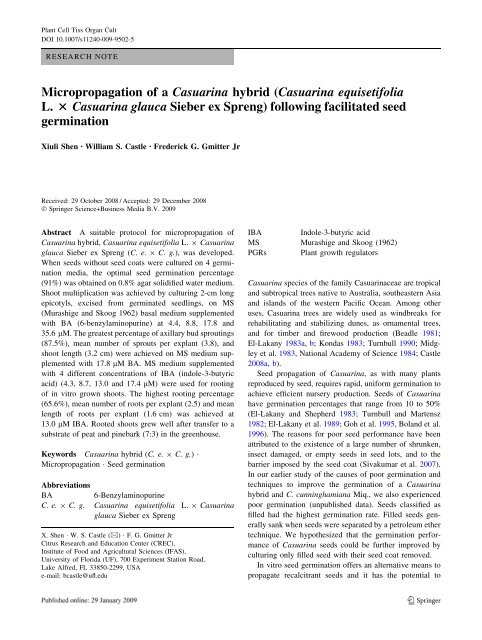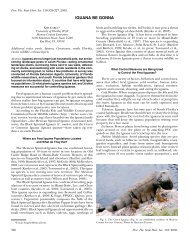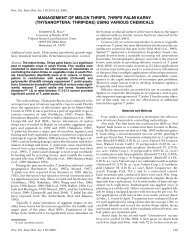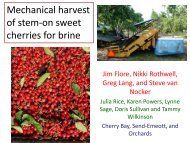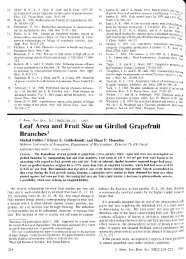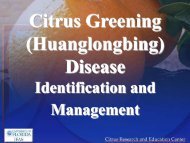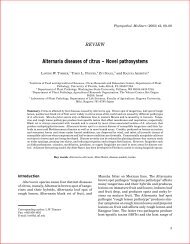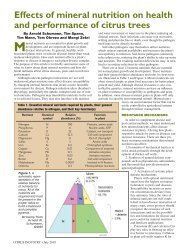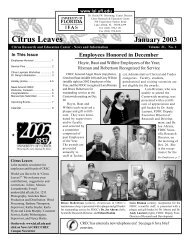Micropropagation of a Casuarina hybrid - Citrus Research and ...
Micropropagation of a Casuarina hybrid - Citrus Research and ...
Micropropagation of a Casuarina hybrid - Citrus Research and ...
Create successful ePaper yourself
Turn your PDF publications into a flip-book with our unique Google optimized e-Paper software.
Plant Cell Tiss Organ Cult<br />
DOI 10.1007/s11240-009-9502-5<br />
RESEARCH NOTE<br />
<strong>Micropropagation</strong> <strong>of</strong> a <strong>Casuarina</strong> <strong>hybrid</strong> (<strong>Casuarina</strong> equisetifolia<br />
L. 3 <strong>Casuarina</strong> glauca Sieber ex Spreng) following facilitated seed<br />
germination<br />
Xiuli Shen Æ William S. Castle Æ Frederick G. Gmitter Jr<br />
Received: 29 October 2008 / Accepted: 29 December 2008<br />
Ó Springer Science+Business Media B.V. 2009<br />
Abstract A suitable protocol for micropropagation <strong>of</strong><br />
<strong>Casuarina</strong> <strong>hybrid</strong>, <strong>Casuarina</strong> equisetifolia L. 9 <strong>Casuarina</strong><br />
glauca Sieber ex Spreng (C. e. 9 C. g.), was developed.<br />
When seeds without seed coats were cultured on 4 germination<br />
media, the optimal seed germination percentage<br />
(91%) was obtained on 0.8% agar solidified water medium.<br />
Shoot multiplication was achieved by culturing 2-cm long<br />
epicotyls, excised from germinated seedlings, on MS<br />
(Murashige <strong>and</strong> Skoog 1962) basal medium supplemented<br />
with BA (6-benzylaminopurine) at 4.4, 8.8, 17.8 <strong>and</strong><br />
35.6 lM. The greatest percentage <strong>of</strong> axillary bud sproutings<br />
(87.5%), mean number <strong>of</strong> sprouts per explant (3.8), <strong>and</strong><br />
shoot length (3.2 cm) were achieved on MS medium supplemented<br />
with 17.8 lM BA. MS medium supplemented<br />
with 4 different concentrations <strong>of</strong> IBA (indole-3-butyric<br />
acid) (4.3, 8.7, 13.0 <strong>and</strong> 17.4 lM) were used for rooting<br />
<strong>of</strong> in vitro grown shoots. The highest rooting percentage<br />
(65.6%), mean number <strong>of</strong> roots per explant (2.5) <strong>and</strong> mean<br />
length <strong>of</strong> roots per explant (1.6 cm) was achieved at<br />
13.0 lM IBA. Rooted shoots grew well after transfer to a<br />
substrate <strong>of</strong> peat <strong>and</strong> pinebark (7:3) in the greenhouse.<br />
Keywords <strong>Casuarina</strong> <strong>hybrid</strong> (C. e. 9 C. g.)<br />
<strong>Micropropagation</strong> Seed germination<br />
Abbreviations<br />
BA 6-Benzylaminopurine<br />
C. e. 9 C. g. <strong>Casuarina</strong> equisetifolia L. 9 <strong>Casuarina</strong><br />
glauca Sieber ex Spreng<br />
X. Shen W. S. Castle (&) F. G. Gmitter Jr<br />
<strong>Citrus</strong> <strong>Research</strong> <strong>and</strong> Education Center (CREC),<br />
Institute <strong>of</strong> Food <strong>and</strong> Agricultural Sciences (IFAS),<br />
University <strong>of</strong> Florida (UF), 700 Experiment Station Road,<br />
Lake Alfred, FL 33850-2299, USA<br />
e-mail: bcastle@ufl.edu<br />
IBA Indole-3-butyric acid<br />
MS Murashige <strong>and</strong> Skoog (1962)<br />
PGRs Plant growth regulators<br />
<strong>Casuarina</strong> species <strong>of</strong> the family <strong>Casuarina</strong>ceae are tropical<br />
<strong>and</strong> subtropical trees native to Australia, southeastern Asia<br />
<strong>and</strong> isl<strong>and</strong>s <strong>of</strong> the western Pacific Ocean. Among other<br />
uses, <strong>Casuarina</strong> trees are widely used as windbreaks for<br />
rehabilitating <strong>and</strong> stabilizing dunes, as ornamental trees,<br />
<strong>and</strong> for timber <strong>and</strong> firewood production (Beadle 1981;<br />
El-Lakany 1983a, b; Kondas 1983; Turnbull 1990; Midgley<br />
et al. 1983, National Academy <strong>of</strong> Science 1984; Castle<br />
2008a, b).<br />
Seed propagation <strong>of</strong> <strong>Casuarina</strong>, as with many plants<br />
reproduced by seed, requires rapid, uniform germination to<br />
achieve efficient nursery production. Seeds <strong>of</strong> <strong>Casuarina</strong><br />
have germination percentages that range from 10 to 50%<br />
(El-Lakany <strong>and</strong> Shepherd 1983; Turnbull <strong>and</strong> Martensz<br />
1982; El-Lakany et al. 1989; Goh et al. 1995, Bol<strong>and</strong> et al.<br />
1996). The reasons for poor seed performance have been<br />
attributed to the existence <strong>of</strong> a large number <strong>of</strong> shrunken,<br />
insect damaged, or empty seeds in seed lots, <strong>and</strong> to the<br />
barrier imposed by the seed coat (Sivakumar et al. 2007).<br />
In our earlier study <strong>of</strong> the causes <strong>of</strong> poor germination <strong>and</strong><br />
techniques to improve the germination <strong>of</strong> a <strong>Casuarina</strong><br />
<strong>hybrid</strong> <strong>and</strong> C. cunninghamiana Miq., we also experienced<br />
poor germination (unpublished data). Seeds classified as<br />
filled had the highest germination rate. Filled seeds generally<br />
sank when seeds were separated by a petroleum ether<br />
technique. We hypothesized that the germination performance<br />
<strong>of</strong> <strong>Casuarina</strong> seeds could be further improved by<br />
culturing only filled seed with their seed coat removed.<br />
In vitro seed germination <strong>of</strong>fers an alternative means to<br />
propagate recalcitrant seeds <strong>and</strong> it has the potential to<br />
123
overcome all limitations <strong>of</strong> traditional seed propagation<br />
(Fay 1991, 1992). Only a few studies on in vitro propagation<br />
<strong>of</strong> <strong>Casuarina</strong> have been reported due to its<br />
recalcitrant nature (Duhoux et al. 1986; Parthiban et al.<br />
1997; Seth et al. 2007). There are no reports <strong>of</strong> in vitro<br />
micropropagation <strong>of</strong> <strong>Casuarina</strong> <strong>hybrid</strong>s. Therefore, the<br />
objective <strong>of</strong> this study was to establish a protocol for<br />
efficient seed germination <strong>and</strong> micropropagation <strong>of</strong> a<br />
<strong>Casuarina</strong> <strong>hybrid</strong> (C. equisetifolia L. 9 C. glauca Sieber<br />
ex Spreng) <strong>and</strong> examine the effects <strong>of</strong> BA <strong>and</strong> IBA plant<br />
growth regulators (PGRs) on shoot multiplication <strong>and</strong> root<br />
formation, respectively.<br />
Brown cones ca. 11 months old were collected on<br />
March 5, 2008 from a naturalized mature <strong>hybrid</strong><br />
(C. e. 9 C. g.) tree <strong>of</strong> unknown age. The tree was located<br />
about 15 km west <strong>of</strong> Vero Beach, Florida (Lat. 27.70123,<br />
Long. 80.50877) <strong>and</strong> growing along a ditch bank within a<br />
citrus grove. The <strong>hybrid</strong> nature <strong>of</strong> the plant was determined<br />
by AFLP (amplified fragment length polymorphism)<br />
analysis (pers. comm., John Gaskin, USDA-ARS). Cones<br />
were allowed to dehisce at room temperature (20°C) for<br />
2 days. Seeds <strong>and</strong> cones were placed in plastic bags <strong>and</strong><br />
shaken to ensure that all seeds were collected. Seeds <strong>of</strong><br />
<strong>Casuarina</strong> are a tiny (\5 mm in length) dry, indehiscent<br />
samara with a single wing.<br />
In a preliminary experiment, the optimal treatment for<br />
seed sterilization <strong>and</strong> seed coat s<strong>of</strong>tening was immersion <strong>of</strong><br />
seeds in 5 N NaOH (sodium hydroxide) for 15 min followed<br />
by soaking in sterile water for 48 h. The media tested<br />
for seed germination were: (1) water; (2) MS (Murashige<br />
<strong>and</strong> Skoog 1962) basal medium; (3) MS basal medium plus<br />
3% sucrose; <strong>and</strong> (4) MS basal medium supplemented with<br />
3% sucrose <strong>and</strong> 1.6 g l -1 NH4NO3 (ammonium nitrate).<br />
Media were adjusted to pH 5.8 with 0.1 N NaOH prior to the<br />
addition <strong>of</strong> 8 g l -1 TC agar (Fisher BioReagents, Fair<br />
Lawn, New Jersey) <strong>and</strong> autoclaved at 1.2 kg cm -2 for<br />
30 min. Seed coats were carefully removed under an optical<br />
microscope (Leica Zoom 2000, model Z45L, Leica Inc.<br />
Buffalo, NY, U.S.A.). Only filled, fully developed seeds were<br />
used for germination (Fig. 1). They were generally larger <strong>and</strong><br />
s<strong>of</strong>ter with a light creamy color compared to shrunken or<br />
presumed insect damaged seeds. Seeds were cultured in<br />
100 9 15 mm 2 Petri dishes containing 20 ml <strong>of</strong> medium.<br />
There were 5 seeds per Petri dish <strong>and</strong> 10 replicate dishes per<br />
treatment. Once seeds germinated, they were transferred to<br />
GA-7 vessels (Magenta Corporation, Chicago, U.S.A.) containing<br />
the same medium for another 4 weeks <strong>of</strong> growth.<br />
Seedlings were kept in a culture room at a temperature <strong>of</strong><br />
22 ± 3°C with 12 h dark <strong>and</strong> 12 h light photoperiod at<br />
40 lmol m -2 s -1 provided by cool white fluorescent lamps<br />
(Lithonia Lighting F40 W/SS, Georgia, U. S. A.). The<br />
number <strong>of</strong> germinated seeds was recorded at the end <strong>of</strong><br />
2 weeks <strong>and</strong> the germination percentage calculated.<br />
123<br />
Plant Cell Tiss Organ Cult<br />
Fig. 1 <strong>Casuarina</strong> <strong>hybrid</strong> (C. e. 9 C. g.) seed types as observed<br />
without seed coats. From left to right: insect-damaged, shrunk <strong>and</strong><br />
filled seeds. Only filled seeds were used in the present study.<br />
Bar = 1000.00 lm<br />
Seed germination was the best on 8 g l -1 agar solidified<br />
water medium (Table 1). Only seedlings germinated on this<br />
medium were used for the shoot multiplication experiment<br />
to avoid any carry-over effect <strong>of</strong> germination media on<br />
shoot multiplication. Epicotyls about 2 cm in length were<br />
severed <strong>and</strong> cultured on shoot multiplication media which<br />
included MS basal medium plus 3% sucrose <strong>and</strong> supplemented<br />
with BA at 4.4, 8.8, 17.8 <strong>and</strong> 35.6 lM. Medium free<br />
<strong>of</strong> BA was used as the control. There were 4 explants per<br />
GA-7 vessel <strong>and</strong> 8 replicate GA-7 vessels for each treatment.<br />
Cultures were kept in a culture room under the same<br />
conditions <strong>of</strong> seed germination. After 6 weeks <strong>of</strong> culture,<br />
data on the number <strong>of</strong> explants with sprouted axillary buds,<br />
the number <strong>of</strong> sprouts per explant <strong>and</strong> shoot length were<br />
taken <strong>and</strong> the percentage <strong>of</strong> axillary bud sprouting was<br />
calculated.<br />
The best shoot multiplication was achieved on the MS<br />
medium supplemented with 17.8 lM BA (Table 2), <strong>and</strong><br />
only shoots produced on this treatment were used for the<br />
Table 1 Seed germination <strong>of</strong> a <strong>Casuarina</strong> <strong>hybrid</strong> (C. e. 9 C. g.)on4<br />
media after 2 weeks culture at 22°C with a 12/12 h light/dark<br />
photoperiod<br />
Medium Germination (%) a<br />
H2O 91 ± 0.3a<br />
MS 45 ± 0.5b<br />
MS ? 3% sucrose 33 ± 0.5bc<br />
MS ? 3% sucrose ? 1.6 g/l NH4NO3 21 ± 0.4c<br />
a Means followed by the same letter in each column are not significantly<br />
different at 0.05 level. Data are means <strong>of</strong> 10 replicates <strong>and</strong> 5<br />
samples per replicate
Plant Cell Tiss Organ Cult<br />
Table 2 Effect <strong>of</strong> BA concentration on shoot proliferation after<br />
6 weeks <strong>of</strong> culturing <strong>Casuarina</strong> <strong>hybrid</strong> (C. e. 9 C. g.) epicotyls on<br />
MS medium<br />
BA<br />
concentration<br />
(lM)<br />
Sprouted<br />
axillary<br />
bud (%)<br />
Mean number<br />
<strong>of</strong> sprouts/<br />
explant ± SE a<br />
Shoot<br />
length<br />
(cm) ± SE<br />
0 40.7 ± 0.1c 1.4 ± 0.2d 2.3 ± 0.1b<br />
4.4 62.5 ± 0.1b 2.0 ± 0.2c 2.3 ± 0.1b<br />
8.8 78.1 ± 0.1ab 2.4 ± 0.2c 2.5 ± 0.1b<br />
17.8 87.5 ± 0.1a 3.8 ± 0.2a 3.2 ± 0.1a<br />
35.6 84.3 ± 0.1a 3.2 ± 0.2b 3.0 ± 0.1a<br />
a Means followed by the same letter in each column are not significantly<br />
different at 0.05 level. Data are means <strong>of</strong> 8 replicates <strong>and</strong> 4<br />
samples per replicate<br />
rooting experiment. Proliferated shoots were removed from<br />
the GA-7 vessels <strong>and</strong> cultured on root induction media<br />
made <strong>of</strong> MS basal medium plus 3% sucrose <strong>and</strong> IBA at 4.3,<br />
8.7, 13.0 <strong>and</strong> 17.4 lM. Medium without IBA served as the<br />
control. There were 4 shoots per GA-7 vessel <strong>and</strong> 8 replicate<br />
GA-7 vessels for each treatment. Cultures were kept in the<br />
same culture room as described above. The number <strong>of</strong><br />
shoots forming roots, root number, <strong>and</strong> the length <strong>of</strong> longest<br />
root <strong>of</strong> each shoot were recorded after 6 weeks induction<br />
<strong>and</strong> the rooting percentage was calculated. For acclimatization,<br />
plantlets (shoots with roots) longer than 3 cm with at<br />
least 2 or 3 needles (branchlets) were removed from GA-7<br />
vessels <strong>and</strong> carefully rinsed to remove any residual<br />
medium. Plantlets were transplanted individually into trays<br />
<strong>of</strong> 50 cells with each 5.0 9 5.0 9 10 cm 3 cell containing a<br />
mixture <strong>of</strong> peat <strong>and</strong> pinebark (7:3). Plantlets were covered<br />
for the first 2 weeks with a clear plastic tray to maintain<br />
high humidity. All plantlets were maintained in a greenhouse<br />
under natural photoperiod (10–14.5 h light) at a<br />
temperature range <strong>of</strong> 20–31°C <strong>and</strong> h<strong>and</strong> watered as needed.<br />
Experiments were established in a completely r<strong>and</strong>omized<br />
design. All data were subject to analysis <strong>of</strong> variance<br />
using SAS (SAS Institute Inc 1999). Mean separation was<br />
achieved by the Least Significant Difference test at 95%<br />
level.<br />
We did not observe any contamination following sterilization<br />
<strong>of</strong> the <strong>Casuarina</strong> seeds. Seed coats were very easily<br />
removed under the optical microscope after the NaOH<br />
soaking <strong>and</strong> rinsing with sterile water. Radicles emerged<br />
within 3 days <strong>and</strong> cotyledonary leaves formed within a<br />
week among filled seeds with their coats removed (Fig. 2).<br />
However, culture medium composition had a significant<br />
effect on seed germination percentage. The greatest seed<br />
germination (91%) was obtained on agar solidified water<br />
medium, followed by 45% on MS, 33% on MS plus 3%<br />
sucrose, 21% on MS plus 3% sucrose <strong>and</strong> 1.6 g/l NH4NO3<br />
medium (Table 1). In nature, all <strong>Casuarina</strong> species form<br />
Fig. 2 Seed germination stages in a <strong>Casuarina</strong> <strong>hybrid</strong> (C. e. 9 C. g.).<br />
Seeds were germinated on 0.8% agar solidified water medium for<br />
2 weeks at 22 ± 3°C under 12/12 h light/dark photoperiod: a naked,<br />
filled seeds; b radicle development <strong>and</strong> emergence <strong>of</strong> cotyledonary<br />
leaves; c, d developing seedlings; <strong>and</strong> e a fully developed seedling<br />
with root <strong>and</strong> exp<strong>and</strong>ed cotyledonary leaves<br />
root nodules with the soil actinomycete Frankia which fixes<br />
atmospheric nitrogen <strong>and</strong> stimulates tree growth (Kang<br />
1996; Mark et al. 1998; Zimpfer et al. 2004). However,<br />
when the MS medium was supplemented with 1.6 g/l<br />
NH4NO3 which doubled the N content compared to MS<br />
medium alone, there were no beneficial effects on seed<br />
germination. During seed germination, external nutrients in<br />
the medium were apparently not required. The germination<br />
rate decreased as the medium nutrient supplement increased<br />
(Table 2). The most critical factor was water content, i.e.,<br />
increased media water content resulted in higher germination<br />
percentages. The results suggest that the nutrients<br />
stored in the cotyledons were sufficient to support seed<br />
germination.<br />
<strong>Casuarina</strong> seeds have a low germination percentage,<br />
<strong>of</strong>ten \50%, under commercial nursery conditions with<br />
intact seeds planted in soil (Bol<strong>and</strong> et al. 1996; Jerlin <strong>and</strong><br />
Srimathis 1997). In our previous study with intact seeds <strong>of</strong><br />
the <strong>Casuarina</strong> <strong>hybrid</strong> (C. e. 9 C. g.), seed germination was<br />
only about 1% in soil <strong>and</strong> 4% on agar solidified medium<br />
when intact seeds were tested (unpublished data). In the<br />
current study, the highest seed germination percentage<br />
through in vitro culture was 91%. There are two explanations<br />
for this improvement: (1) only fully developed, filled<br />
seeds were cultured. Seeds with low expectancy for germination<br />
(shrunken, insect damaged <strong>and</strong> empty) were<br />
identified under the optical microscope <strong>and</strong> eliminated; <strong>and</strong><br />
(2) seed coats were removed, thus, reducing their impediment<br />
to germination.<br />
Shoot proliferation readily occurred on multiplication<br />
media (Fig. 3a) <strong>and</strong> was significantly affected by the<br />
medium BA concentration (Table 2). Although 40.7% <strong>of</strong><br />
the explants sprouted axillary buds without BA, the number<br />
123
Fig. 3 <strong>Micropropagation</strong> <strong>of</strong> a <strong>Casuarina</strong> <strong>hybrid</strong> (C. e. 9 C. g.): a<br />
shoot multiplication <strong>of</strong> epicotyls excised from germinated seeds <strong>and</strong><br />
cultured on MS medium supplemented with 17.8 lM BA for 6 weeks<br />
at a temperature <strong>of</strong> 22 ± 3°C with 12/12 h light/dark photoperiod; b<br />
roots induced on MS medium supplemented with 13.0 lM IBA from<br />
<strong>of</strong> sprouts per explant was very low, only 1.4. With the<br />
addition <strong>of</strong> BA to the medium at increasing concentrations,<br />
significant increases in the percentage <strong>of</strong> sprouted axillary<br />
buds <strong>and</strong> mean number <strong>of</strong> sprouts per explant occurred at<br />
all BA concentrations. However, shoot length was only<br />
significantly increased at the 2 highest BA concentrations.<br />
It is well established that BA is the best cytokinin for<br />
stimulating shoot multiplication in a broad range <strong>of</strong> species<br />
(Gaspar et al. 1996). Our greatest shoot multiplication, i.e.,<br />
87.5% sprouted axillary buds, 3.8 sprouts per explant <strong>and</strong><br />
an average shoot length <strong>of</strong> 3.2 cm, was obtained on MS<br />
supplemented with 17.8 lM BA. In the absence <strong>of</strong> BA,<br />
explants responded poorly. In other reports, 11.1 lM BA<br />
was optimal for sprouting <strong>of</strong> axillary buds (5.78 buds per<br />
explant) from immature female inflorescence explants in<br />
C. equisetifolia (Duhoux et al. 1986), <strong>and</strong> 4.44 lM BA<br />
produced 73.8% axillary bud sprouting <strong>and</strong> 3.81 sprouts<br />
per explant in a study <strong>of</strong> clonal propagation <strong>of</strong> C. equisetifolia<br />
using shoot tips as explants (Seth et al. 2007).<br />
These results suggest that optimal BA concentration for<br />
shoot multiplication depends on species <strong>and</strong> type <strong>of</strong> explant<br />
tissue.<br />
Rooting is the biggest hindrance to the propagation <strong>of</strong><br />
woody plants (Murashige 1974; Zimmerman 1988, Hartmann<br />
et al. 1990, Thorpe <strong>and</strong> Harry 1990). This is<br />
confirmed by our experience in several attempts to root<br />
cuttings <strong>of</strong> C. cunninghamiana through conventional mist<br />
bed <strong>and</strong> water culture techniques (Castle 2007).<br />
In the current study, rooting performance was greatly<br />
improved by the presence <strong>of</strong> IBA in the medium (Fig. 3-b).<br />
No root formation was observed on the control medium<br />
without IBA <strong>and</strong> most plants became yellow <strong>and</strong> eventually<br />
died over a period <strong>of</strong> 6 weeks. Rooting percentage,<br />
root number per explant <strong>and</strong> root length per explant significantly<br />
increased as IBA concentration increased<br />
123<br />
proliferated shoots after 6 weeks culture under the same conditions as<br />
shoot multiplication; <strong>and</strong>, c plantlets transplanted to a potting mixture<br />
<strong>of</strong> peat <strong>and</strong> pinebark (7:3) in plastic trays placed in a greenhouse<br />
(Bar = 1 cm)<br />
Table 3 Effect <strong>of</strong> IBA concentration on root development in <strong>Casuarina</strong><br />
<strong>hybrid</strong> (C. e. 9 C. g.) explants after 6 weeks <strong>of</strong> culture on MS<br />
medium<br />
IBA<br />
concentration<br />
(lM)<br />
Rooting<br />
(%)<br />
Plant Cell Tiss Organ Cult<br />
Mean number<br />
<strong>of</strong> roots/<br />
explant ± SE a<br />
Mean length<br />
<strong>of</strong> roots/<br />
explant ± SE<br />
0 0c 0c 0d<br />
4.3 37.5 ± 0.1b 1.1 ± 0.1b 0.6 ± 0.1c<br />
8.7 46.9 ± 0.1b 1.3 ± 0.1b 0.6 ± 0.1c<br />
13.0 65.6 ± 0.1a 2.5 ± 0.1a 1.6 ± 0.1a<br />
17.4 53.1 ± 0.1ab 1.5 ± 0.1b 1.0 ± 0.1b<br />
a Means followed by the same letter in each column are not significantly<br />
different at 0.05 level. Data are means <strong>of</strong> 8 replicates <strong>and</strong> 4<br />
samples per replicate<br />
(Table 3). The highest rooting percentage (65.6%) was<br />
obtained on MS supplemented with 13.0 lM IBA. The<br />
largest root number (2.5) <strong>and</strong> root length per explant<br />
(1.6 cm) were also produced at this concentration, but<br />
declined at the higher concentration.<br />
All regenerated plantlets grew well under greenhouse<br />
conditions (Fig. 3c). Therefore, we demonstrated that in<br />
vitro root induction appears to be an alternative means for<br />
propagation <strong>of</strong> difficult-to-root species. Inclusion <strong>of</strong> auxin<br />
in the medium is a common <strong>and</strong> effective method to<br />
stimulate adventitious root formation in vitro (Gavidia<br />
et al. 1996; De Klerk 2002). Plants have been divided into<br />
3 classes according to their dependence on auxin for<br />
rooting (Noiton et al. 1992; Pruski et al. 2000). <strong>Casuarina</strong><br />
seems to belong to the class in which exogenous auxin is<br />
required <strong>and</strong> can stimulate adventitious root formation.<br />
However, the type <strong>and</strong> concentration <strong>of</strong> auxin that determine<br />
optimal rooting response depends mainly on species,<br />
type <strong>of</strong> explant tissue <strong>and</strong> the developmental stage <strong>of</strong> the<br />
plant (Abdullah et al. 1989; De Klerk et al. 1997).
Plant Cell Tiss Organ Cult<br />
In conclusion, a protocol for in vitro propagation <strong>of</strong><br />
Causarina <strong>hybrid</strong> (C. e. 9 C. g.) following facilitated seed<br />
germination was established. The protocol consists <strong>of</strong> 4<br />
steps, namely seed germination, shoot multiplication,<br />
rooting <strong>and</strong> acclimatization. Seed germination, shoot multiplication<br />
<strong>and</strong> rooting performance can be optimized by<br />
manipulation <strong>of</strong> the culture medium. This in vitro culture<br />
protocol provides an alternative means for propagation <strong>of</strong><br />
<strong>Casuarina</strong> <strong>and</strong> has a potential for large scale propagation on<br />
a year-round basis.<br />
References<br />
Abdullah AA, Grace J, Yeoman NM (1989) Rooting <strong>and</strong> establishment<br />
<strong>of</strong> calabrian pine plantlets propagated in vitro: influence <strong>of</strong><br />
growth substance, rooting medium <strong>and</strong> origin <strong>of</strong> explant. New<br />
Phytol 113:193–202. doi:10.1111/j.1469-8137.1989.tb04706.x<br />
Beadle NCW (1981) The vegetation <strong>of</strong> Australia. Cambridge<br />
University Press, Cambridge<br />
Bol<strong>and</strong> DJ, Moncur MW, Pinyopusarerk K (1996) Review <strong>of</strong> some<br />
floral <strong>and</strong> vegetative aspects to consider when domesticating<br />
<strong>Casuarina</strong>. In: Pinyopusarerk K, Turnbull JW, Midgley SJ (eds)<br />
Recent <strong>Casuarina</strong> <strong>Research</strong> <strong>and</strong> Development, Proceedings <strong>of</strong><br />
the Third International <strong>Casuarina</strong> Workshop, Da Nang, Vietnam,<br />
4–7 March 1996, pp 17–25<br />
Castle WS (2007) Windbreaks for citrus. University <strong>of</strong> Florida<br />
website at http://www.crec.ifas.ufl.edu/extension/windbreaks<br />
Castle WS (2008a) <strong>Casuarina</strong> cunninghamiana Miq. (River sheoak)<br />
in Florida <strong>and</strong> its potential as a windbreak plant for citrus groves.<br />
HS 1139, Florida Cooperative Extension Service, Institute <strong>of</strong><br />
Food <strong>and</strong> Agricultural Sciences, University <strong>of</strong> Florida<br />
Castle WS (2008b) Field guide to identify the common <strong>Casuarina</strong><br />
(Australian pine) species in Florida. HS 1140, Florida Cooperative<br />
Extension Service, Institute <strong>of</strong> Food <strong>and</strong> Agricultural<br />
Sciences, University <strong>of</strong> Florida<br />
De Klerk GJ (2002) Rooting <strong>of</strong> microcuttings: theory <strong>and</strong> practice. In<br />
Vitro Cell Dev Biol Plant 38:415–422<br />
De Klerk GJ, Brugge TJ, Marinova S (1997) Effectiveness <strong>of</strong><br />
indoleacetic acid, indolebutyci acid <strong>and</strong> naphthaleneacetic acid<br />
during adventitious root formation in vitro in Malus ‘Jork 9’.<br />
Plant Cell Tissue Organ Cult 49:39–44. doi:10.1023/A:<br />
1005850222973<br />
Duhoux E, Sougoufara B, Dommergues Y (1986) Propagation <strong>of</strong><br />
<strong>Casuarina</strong> equisetifolia through axillary buds <strong>of</strong> immature female<br />
inflorescences cultured in vitro. Plant Cell Rep 3:161–164. doi:<br />
10.1007/BF00269108<br />
El-Lakany MH (1983a) A review <strong>of</strong> breeding drought resistant<br />
<strong>Casuarina</strong> for shelterbelt establishment in arid regions with<br />
special reference to Egypt. For Ecol Manage 6:129–137. doi:<br />
10.1016/0378-1127(83)90017-8<br />
El-Lakany MH (1983b) Breeding <strong>and</strong> improving <strong>Casuarina</strong>: a<br />
promising multipurpose tree for arid regions <strong>of</strong> Egypt. In:<br />
Midgley SJ, Turnbull JW, Johnston RD (eds) <strong>Casuarina</strong> ecology,<br />
management <strong>and</strong> utilization. CSIRO, Melbourne, pp 58–65<br />
El-Lakany MH, Shepherd KR (1983) Variation in seed germinability,<br />
seedling growth, <strong>and</strong> biomass between provenances <strong>of</strong> <strong>Casuarina</strong><br />
cumminghamiana Miq. <strong>and</strong> C. glauca Siev. For Manage<br />
Ecol 6:201–216. doi:10.1016/S0378-1127(83)80003-6<br />
El-Lakany MH, Omran TA, Shehata MS (1989) Variation in seed<br />
characteristics <strong>of</strong> <strong>Casuarina</strong> as affected by species, season <strong>of</strong><br />
collection <strong>and</strong> positions on the tree crown. Int Tree Crops<br />
J 5:237–245<br />
Fay MF (1991) Conservation <strong>of</strong> rare <strong>and</strong> endangered plants using in<br />
vitro methods. In Vitro Cell Dev Biol Plant 28:1–4<br />
Fay MF (1992) In what situations is in vitro culture appropriate to<br />
plant conservations? Biodivers Conserv 3:176–183. doi:10.1007/<br />
BF02291887<br />
Gaspar T, Kevers C, Penel C, Greppin H, Reid DM, Thorpe TA<br />
(1996) Plant hormones <strong>and</strong> plant growth regulators in plant<br />
tissue culture. In Vitro Cell Dev Biol Plant 32:272–289. doi:10.<br />
1007/BF02822700<br />
Gavidia I, Perez-Bermudez P, Segura J (1996) <strong>Micropropagation</strong> <strong>of</strong><br />
bay laurel (Dephne gnidium L.). J Hortic Sci 71:977–983<br />
Goh CJ, Lakshmanan P, Lee CL, Loh CS, Tanaka M (1995) A simple<br />
<strong>and</strong> efficient method for clonal propagation <strong>of</strong> <strong>Casuarina</strong> sumatrana<br />
(de Vriese) L. Johnson. Plant Growth Regul 17:115–120. doi:<br />
10.1007/BF00024170<br />
Hartmann HT, Kester DE, Davies FT (1990) Plant propagation<br />
principles <strong>and</strong> practices. Prentice Hall, Englewood Cliffs, NJ<br />
Jerlin R, Srimathi P (1997) Grading <strong>and</strong> storage potential <strong>of</strong><br />
<strong>Casuarina</strong> equisetifolia seeds. Ann For Sci 5:103–106<br />
Kang L (1996) Effects <strong>of</strong> Frankia inoculation <strong>and</strong> nutrient application<br />
on seedling growth <strong>of</strong> <strong>Casuarina</strong> species. In: Pinyopusarerk K,<br />
Turnbull JW, Midgley SJ (eds) Recent <strong>Casuarina</strong> <strong>Research</strong> <strong>and</strong><br />
Development Proceedings <strong>of</strong> the Third International <strong>Casuarina</strong><br />
Workshop, Da Nang, Vietnam, 4–7 March 1996, pp 59–62<br />
Kondas S (1983) <strong>Casuarina</strong> equisetifolia—a multipurpose tree cash<br />
crop in India. In: Midgley SJ, Turnbull YW, Johnson RD (eds)<br />
<strong>Casuarina</strong> Ecology, Management <strong>and</strong> Utilization. CSIRO,<br />
Australia, pp 66–67<br />
Mark GL, Hooker JE, Hahn A, Wheeler CT (1998) In vitro culture <strong>of</strong><br />
arbuscular mycorrhizal fungus <strong>and</strong> Frankia for inoculation <strong>of</strong><br />
micropropagated <strong>Casuarina</strong> equisetifolia L. Can J Bot 77:1391–<br />
1397<br />
Midgley SJ, Turnbull JW, Johnston RD (eds) (1983) <strong>Casuarina</strong><br />
ecology, management <strong>and</strong> utilization. CSIRO, Melbourne, p 286<br />
Murashige T (1974) Plant propagation through tissue culture. Ann<br />
Rev Plant Physiol 25:135–166<br />
National Academy <strong>of</strong> Science (1984) <strong>Casuarina</strong>: nitrogen-fixing trees<br />
for adverse sites. National Academy <strong>of</strong> Science, Washington, p 118<br />
Noiton D, Vine JH, Mullins MG (1992) Endogenous indole-3-acetic<br />
acid <strong>and</strong> abscisic acid in apple microcuttings in relation to<br />
adventitious root formation. Plant Growth Regul 11:63–67<br />
Parthiban KT, Narayanan R, Rai RSV, Surendran C, Ravich<strong>and</strong>ran<br />
VK (1997) Callogenesis <strong>and</strong> organogenesis in <strong>Casuarina</strong><br />
equisetifolia F. R. & G. Forst. Indian J For 20:227–230<br />
Pruski K, Nowak J, Grainger G (2000) <strong>Micropropagation</strong> <strong>of</strong> four<br />
cultivars <strong>of</strong> Saskatoon berry (Amelanchier alnifolia Nutt.). Plant<br />
Cell Tissue Organ Cult 21:103–109<br />
SAS Institute Inc (1999) Verdion 8.02. SAS Institute, Cary, NC<br />
Seth R, Kendurkar S, Nadgauda R (2007) In vitro clonal propagation<br />
<strong>of</strong> <strong>Casuarina</strong> equisetifolia Forst. from mature tree-derived<br />
explants. Curr Sci 3:287–290<br />
Sivakumar V, An<strong>and</strong>alakshmi R, Warrier RR, Singh BG, Tigabu M,<br />
Oden PC (2007) Petroleum flotation technique upgrades the<br />
germinability <strong>of</strong> <strong>Casuarina</strong> equisetifolia seed lots. New For<br />
34:281–291<br />
Thorpe TA, Harry IS (1990) Special problems <strong>and</strong> prospects in the<br />
propagation <strong>of</strong> woody species. NATO ASI series: Series A: Life<br />
science (USA)<br />
Turnbull JW (1990) Taxonomy <strong>and</strong> genetic variation in <strong>Casuarina</strong>.<br />
In: El-Lakany MH, Turnbull JW, Brewbaker JL (eds) Advances<br />
in <strong>Casuarina</strong> research <strong>and</strong> utilization. Proceedings <strong>of</strong> the Second<br />
International <strong>Casuarina</strong> Workshop, Desert Development Center,<br />
AUC, Cairo, pp 1–11<br />
123
Turnbull JW, Martensz PN (1982) Seed production, collection <strong>and</strong><br />
germination in <strong>Casuarina</strong>ceae. Aust For Res 12:281–294<br />
Zimmerman RH (1988) <strong>Micropropagation</strong> <strong>of</strong> woody plants: post<br />
tissue culture aspects. Acta Hortic 227:489–499<br />
123<br />
Plant Cell Tiss Organ Cult<br />
Zimpfer JF, Igual JM, McCarty B, Smyth C, Dawson JO (2004)<br />
<strong>Casuarina</strong> cunninghamiana tissue extracts stimulate the growth<br />
<strong>of</strong> Frankia <strong>and</strong> differentially alter the growth <strong>of</strong> other soil<br />
microorganisms. J Chem Ecol 30:439–452


